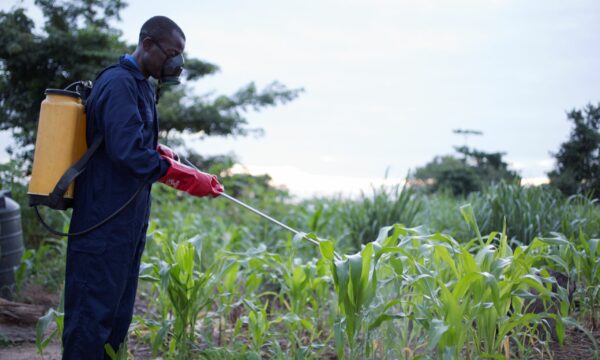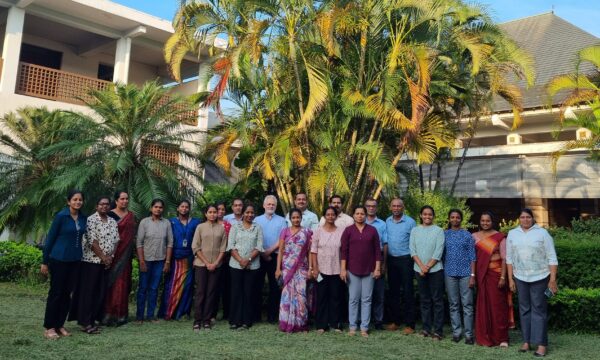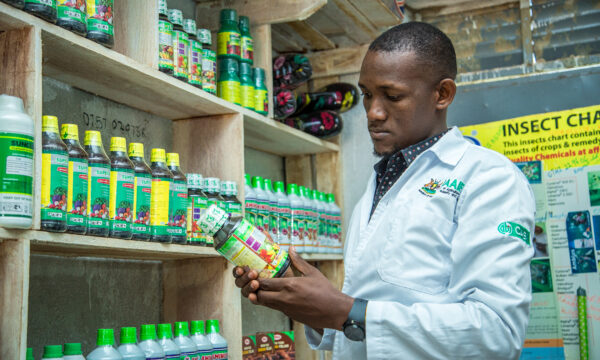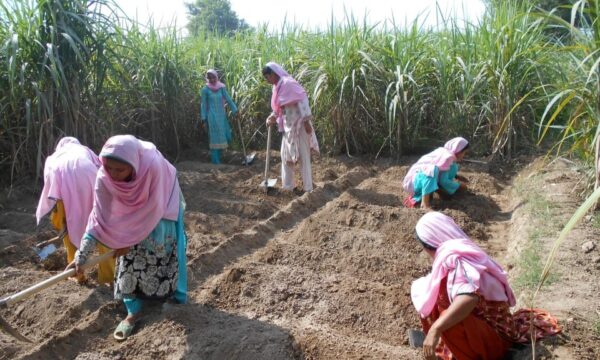The papaya mealybug problem in Kenya
The invasive papaya mealybug (Paracoccus marginatus) is a devastating pest to many crops, with a host range of over 200 plants. The species was first detected in Africa in 2010 in Ghana and then in 2016 in Mombasa County in Kenya.

In Kenya, where horticulture makes up 60% of all export earnings, the pest has caused an estimated 57% yield loss of papaya fruits. Papaya ranked as the country’s fifth most important fruit crop in 2017. The horticulture sector engages many women and young people in the value chain. As such, papaya mealybug presents a threat to livelihoods.
Desperate to save their crop, farmers often incur extra costs purchasing chemical pesticides to manage papaya mealybug. Some farmers resort to using chemical pesticides not registered to control papaya mealybug. Aside from the high cost, chemical pesticides pose many health risks to humans and the environment. Particularly when they are poorly handled or improperly disposed of.
Using biocontrol against papaya mealybug
In its native range in Central America, natural enemies, such as parasitoids, help to control the papaya mealybug population. Biological control (biocontrol), particularly classical biological control (CBC), is recommended in places like Kenya. This involves introducing a biological control agent (BCA) from the pests’ native range that will be able to regulate the pest population. CBC is a sustainable and cost-effective management method suitable for smallholder farmers.
The parasitoid wasp, Acerophagus papayae, has successfully controlled papaya mealybug in other countries, including Ghana, Guam, Palau, Sri Lanka, Puerto Rico, and the Dominican Republic. Recently, the Kenya Technical Standing Committee on Imports and Exports (KSTCIE) approved the import of A. papayae from Ghana into Kenya. Following efficacy testing under laboratory conditions, PlantwisePlus and partners* obtained approval for the release of the parasitoid in selected counties on Kenya’s coastline in 2021.
This is a positive step since Integrated Pest Management (IPM), which includes biocontrol, is rarely carried out in Kenya. Studies have shown that farmers rely on chemical pesticides as they are unaware of alternatives such as biocontrol. This is due to a need for more information dissemination to farming communities.
How do smallholder farmers feel about using biocontrol?

A recent CABI study aimed to determine farmers’ current knowledge, attitudes, and practices toward the biocontrol of papaya mealybug. The study’s aim was to understand the different factors affecting farmers’ willingness to support the biocontrol of papaya mealybug and reduce their chemical pesticide use.
The study used a combination of household surveys, key informant interviews, and focus group discussions. The researchers selected counties based on papaya growing, the presence of papaya mealybug and potential A. papayae release sites. Three coastal counties were included in the study: Mombasa, Kilifi, and Kwale, alongside Machakos, an inland county where papaya mealybug is also found.
Trained enumerators used validated and pre-tested questionnaires during face-to-face interviews in October 2021. A total of 383 smallholders, 148 of whom were women, participated in the study. Key informant interviews with eight extension agents and thirty agro-dealers also took place using prepared question guides. In addition, eight focus group discussions were conducted with papaya farmers, including 87 participants.
Farmers’ knowledge and attitudes towards biocontrol
Papaya mealybug is a serious problem for most of these farmers; over 95% reported the pest presence on their farms. Over half (56%) reported not using any method of controlling papaya mealybug, while 27% used chemical pesticides. A high proportion of farmers demonstrated awareness of the health (77%) and environmental (74%) risks of chemical pesticides.
Among the respondents, 51% had heard of biocontrol and mentioned specific examples like birds, beetles, and spiders. Yet, extension agents estimate that only around 18% of farmers actually use biocontrol methods. Despite this, for those farmers who were aware of biocontrol, 94% viewed the practice as safe, 79% as affordable, and 72% as effective.

However, there were some negative perceptions, like biocontrol is slow to work and labour-intensive (53% and 43% of respondents, respectively). It was also apparent that men were more willing to use biocontrol, even if women are generally more inclined to favour safer practices. This emphasizes the need to increase women’s knowledge of biocontrol practices.
The opinions of those advising farmers often influence farming practices. Extension agents stated that they do not recommend biocontrol products to farmers due to their unaffordability, inaccessibility, and low success rates associated with limited general knowledge of biocontrol practices. Agro-dealers also don’t recommend biocontrols due to low capacity, limited knowledge and packaging quantities that favour large-scale farms rather than smallholders.
Moving forward with biocontrol of papaya mealybug

In terms of willingness to support biocontrol of papaya mealybug, almost 90% viewed the release of the A. papayae as a BCA positively. The farmers added that they knew biocontrol works best at a combined individual and community level. Thus supporting the concept of area-wide management. In fact, 90% of farmers surveyed stated their willingness to work together with their neighbours to manage papaya mealybug.
In addition, over 80% of respondents supported complementary activities for the biocontrol of papaya mealybug, such as cooperative scouting and area-wide crop rotation. Furthermore, a positive correlation was found between awareness of biocontrol, belonging to a farmer association, and receipt of IPM training, and willingness to support a biocontrol initiative.
Since farmers exhibited high levels of willingness to support A. papayae releases as part of a CBC initiative, it is important to ensure continued community engagement and capacity strengthening to increase knowledge and awareness of biocontrol among farmers. An area-wide pest management approach will support the establishment of a self-sustaining population of the parasitoid, which in turn requires support from farmers in the survey localities and more widely.
Farmers need to use management measures complementary to CBC which includes reduced chemical pesticide use. One impactful way of learning is through shared experiences with high value placed on practical learning through field training, demonstration plots, and identifying innovative farmers who can lead by example. Engaging with farmers during the initial stages of a CBC initiative is highlighted as essential to help ensure long-term community ownership, commitment, and sustainability.
Read the study in full:
Constantine, K., Makale, F., Mugambi, I. et al. Smallholder farmers’ knowledge, attitudes and practices towards biological control of papaya mealybug in Kenya. CABI Agric Biosci 4, 18 (2023). https://doi.org/10.1186/s43170-023-00161-7
This research was funded by the CABI-led PlantwisePlus programme, which is financially supported by the Directorate-General for International Cooperation (DGIS), Netherlands; European Commission Directorate General for International Partnerships (INTPA, EU); the Foreign, Commonwealth & Development Office (FCDO), United Kingdom; the Swiss Agency for Development and Cooperation (SDC); the Australian Centre for International Agricultural Research (ACIAR); the Ministry of Agriculture of the People’s Republic of China (MARA).
*To implement the biological control of papaya mealybug in Kenya, PlantwisePlus has partnered with the Kenya Agricultural and Livestock Research Organization (KALRO), Kenya Plant Health Inspectorate Service (KEPHIS), and the National Museums of Kenya.
Find out more
Pest and Disease Photoguide to Papaya disorders
Controlling the papaya mealybug pest – progress made in coastal Kenya
New study reveals willingness of papaya farmers in Kenya to reduce pesticide use
Fight against papaya mealybug in Kenya stepped up with agent release in four more counties
Mass rearing training strengthens papaya mealybug biocontrol programme in Kenya
Natural enemy fight increased against papaya mealybug in Kenya
All images © CABI
1 Comment
Leave a Reply
Related News & Blogs
How do pest risk registers address the spread of plant pests in Africa?
Pest risk registers can help to solve problems in agriculture, addressing the growing global threat of plant pests. Moreover, changing weather patterns, led by rising temperatures, are causing them to reproduce faster and expand into new regions. In ad…
10 July 2025





These same species of meally bugs are very severe attacked at cotton crops in pakistan province of Sindh distic of matiary sanghar meer pur khas and tando Allah yaar distics kindly share it’s biological control of meally bugs for cotton crops